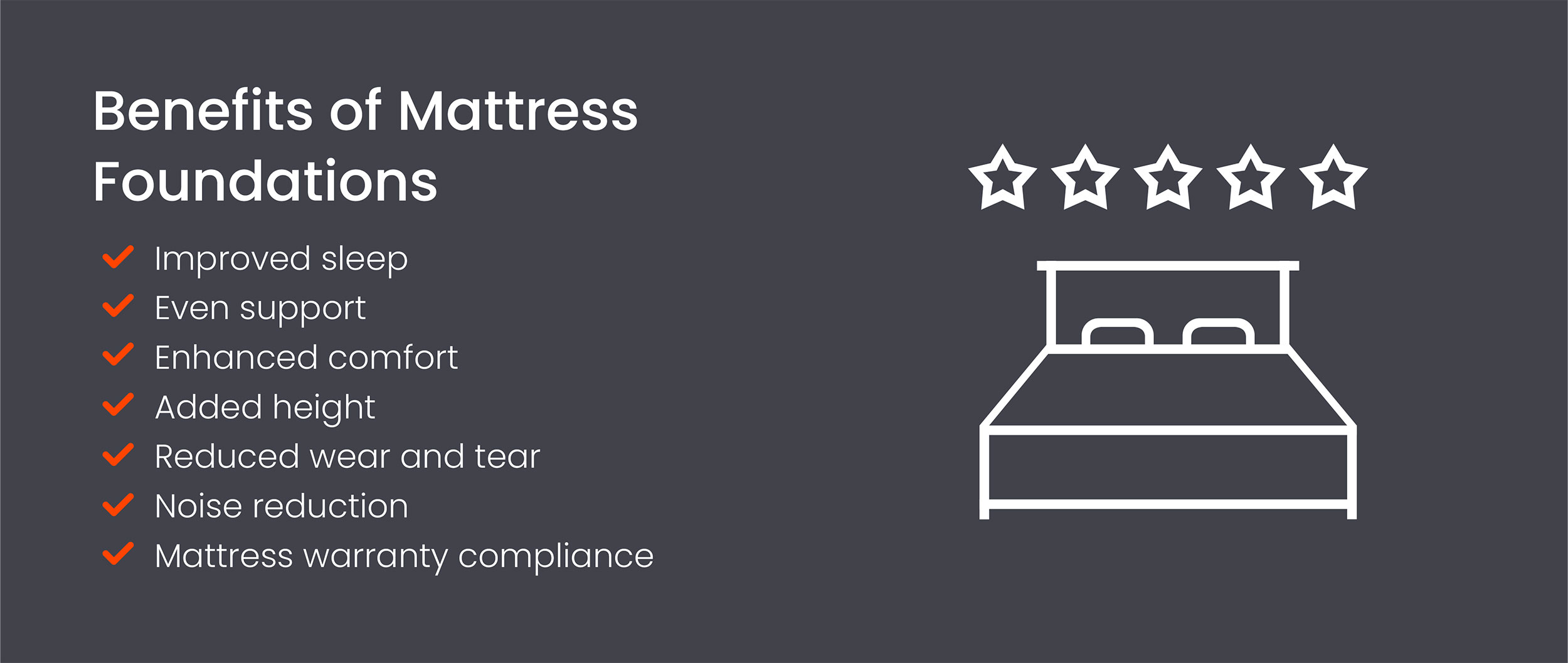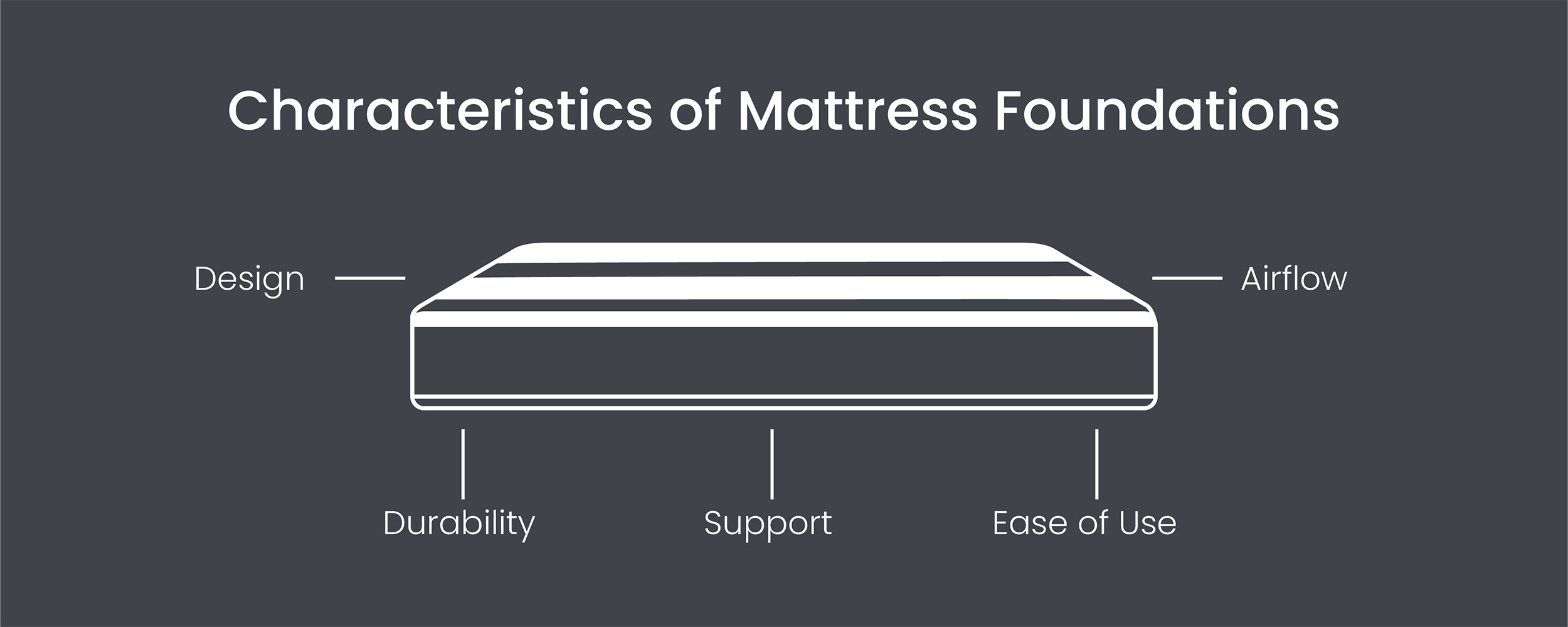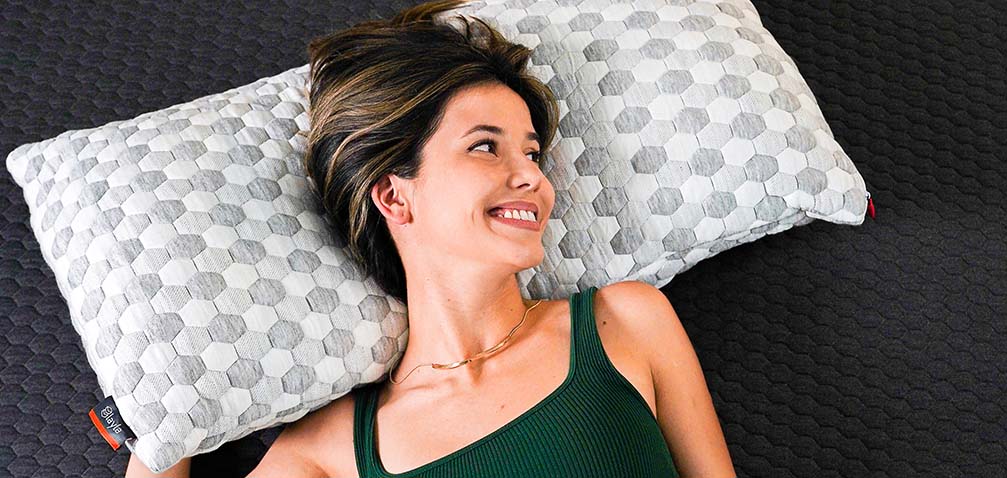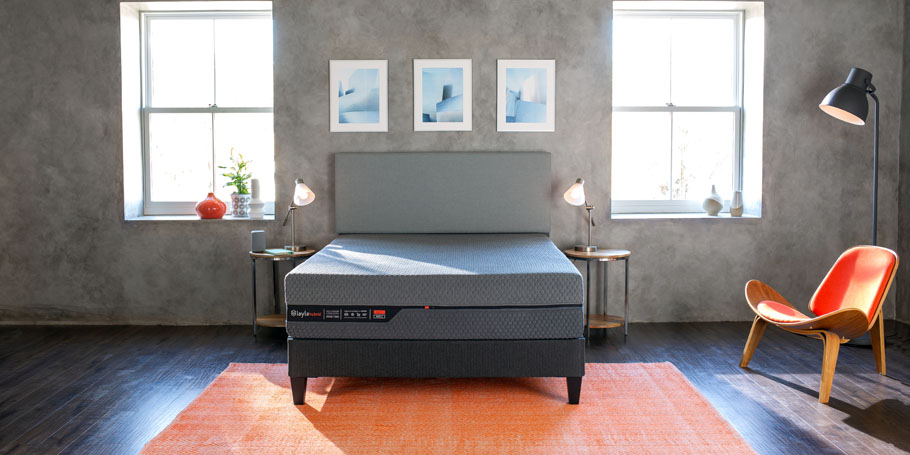A mattress foundation provides support for your mattress without the need for a box spring or any additional support items; it gives you everything you need to keep your mattress in good shape, eliminating sagginess and evenly distributing your weight while keeping your bed off the floor.
A new mattress foundation is worth the investment. A solid foundation means more REM sleep, but a bad one will make you feel like the Princess and the Pea. So, how do you know if you’re getting the best mattress foundation for your bed? Here are some tips for why a mattress foundation matters so much and what to look for.
- Key Takeaways
- What Is a Mattress Foundation?
- What Are the Benefits of Using a Mattress Foundation?
- What Are the Different Types of Mattress Foundations?
- What Should You Look For in a Mattress Foundation?
- How to Know If You Have the Right Foundation
- How Do You Maintain Your Mattress Foundation?
- Do I Need a Foundation for My Mattress?
- What Is the Difference Between a Mattress Foundation and Box Spring?
- Wrapping Up: Choosing the Right Memory Foam Mattress Foundation
Key Takeaways
- Mattress foundations provide essential support for your mattress, ensuring longevity and comfort.
- The right mattress foundation can improve sleep quality, enhance support, and reduce wear and tear on your mattress.
- Proper maintenance can prevent wear and tear to keep your mattress foundation in good shape.
- Compatibility with your mattress and adherence to manufacturer guidelines can help you choose the best mattress foundation for your needs.
What Is a Mattress Foundation?
A mattress foundation is a support system. It’s what you put underneath your mattress to give it stability and prolong its lifespan. It can be made of different materials, like wood or metal, and it usually sits on your bed frame. Its job is to evenly distribute weight and provide support to your mattress so you can sleep comfortably.
A bed frame and a mattress foundation are both important parts of your bed setup, but they serve different purposes. A bed frame is like the skeleton of your bed—it’s the structure that holds everything together. It usually consists of side rails to form a rectangle and sometimes a center support beam. Its main job is to provide a sturdy frame for your new mattress and to elevate it off the ground. They’re designed to be used with box springs or foundations.
On the other hand, a mattress foundation goes directly under your mattress to support it. It’s there to make sure your mattress stays stable and doesn’t sag. There are many types of bed bases, and mattress foundations can be made of materials like wood or metal. They come in different styles, such as solid platforms or slatted designs. Their main purpose is to evenly distribute weight and provide a solid base for your mattress to rest on, and they can be used with all types of mattresses.
What Are the Benefits of Using a Mattress Foundation?
A mattress foundation can offer several benefits, making it a worthwhile addition to your bed setup.

- Improved sleep: A mattress foundation provides a stable and supportive base, promoting better sleep quality by alleviating pressure points and ensuring a comfortable sleeping surface.
- Even support: It distributes weight evenly across the mattress, preventing sagging and maintaining its shape over time. Whether you have a mattress for scoliosis or just something to keep you comfy, you’ll need a mattress foundation to provide support that keeps you supported and pain-free.
- Enhanced comfort: A mattress foundation enhances overall comfort during sleep by offering consistent support.
- Added height: The foundation raises the bed, making it easier to get in and out. This can be particularly beneficial for people who have difficulty entering or exiting the bed.
- Reduced wear and tear: By pulling the mattress off the floor, a foundation reduces direct contact with dirt and grime, extending its lifespan by reducing wear and tear.
- Noise reduction: Foundations can absorb movement and prevent squeaking or creaking sounds, contributing to a quieter sleeping environment. Whether you start sleeping on your stomach and end up on your side or have a partner or pet who moves around a lot, mattress foundations can help you get a better night’s sleep by completely eliminating squeaks from a metal bed frame.
- Mattress warranty compliance: Many mattress warranties require the use of a proper support system, such as a mattress foundation, to maintain coverage, ensuring compliance and protecting your investment.
What Are the Different Types of Mattress Foundations?
Mattress foundations are not created equally. If you’re investing in a quality memory foam bed, you don’t want to sit it on a flimsy foundation. Here are some of the main types of mattress foundations you’ll see on the market:
- Bunkie Boards: Bunkie what now? These thin platforms are usually made from solid plywood. They sit inside the bed frame to offer support to the top mattress. They float inside the frame, making them discrete, but they may be harder to position than a more substantial foundation. They don’t offer any lift, so you’ll be sleeping low.
- Platform Beds: These beds have a lip in the bottom frame where you can put a series of wooden planks. Similar to a bunkie board, these foundations might offer some support – but they won’t lift up your mattress, and you’ll probably have to sit down to get into your bed.
- Box Spring Mattresses: Box springs were all the rage for a long time. In fact, they were so popular that most mattress stores began selling box spring/mattress sets. If you walk into a big retailer looking for a bed, you can bet your bottom Venmo transfer that they’ll still try to sell you a box spring foundation. These foundations provide a lift to your bed and are filled with supportive coils.
- Wood Slat Foundations: Slat foundations are becoming more and more popular. They have a solid wooden frame with wooden planks in the middle. They can usually be covered, so they look like a full box spring mattress from the side. The Layla Mattress Foundation is one example of a plank foundation that provides ample support and lift.
- Adjustable Bed Frames: These allow you to adjust the position of your mattress, providing customizable support for different sleeping positions. They’re great for anyone who likes to read in bed, as they can lift the head or foot of the mattress for added comfort.
- Metal Frame Foundations: Made of sturdy metal, these foundations offer reliable support for your mattress. They’re often lightweight and easy to assemble, making them a convenient option for those who move frequently or need a portable foundation.
What Should You Look For in a Mattress Foundation?
If you can’t tell already, we’re partial to our own mattress foundation. But we don’t want you to just take our word for it. You should evaluate any new mattress, frame, or foundation based on the merits of what it can do for you.
As you shop for a new bed foundation, consider how it looks, feels, and lasts. The best characteristics of a bed foundation include:

- Design: You have a grown-up bed. It should have a grown-up look. Low-sitting beds or beds with an exposed support foundation may sell your aesthetic short. A good foundation will blend in with the rest of your bed and have a clean appearance. If you have an elevated bed, bunkie boards and other low foundations work against your look.
- Durability: Raise your hand if you want to replace your bed foundation every few years. No one? Bueller? A great mattress foundation will last the test of time and should have a warranty that guarantees it. Check online reviews to see if other buyers have found the foundation a good fit for the long haul. Ideally, your mattress foundation will last at least as long as your memory foam mattress does.
- Support: Will your plywood bunkie board last a long time? Maybe, but depending on how strong the material is, it could also buckle unexpectedly. How uncomfortable would that be? Keep in mind that if you’re breaking in a mattress, it can take a few weeks to a few months to feel comfortable. However, a great mattress foundation has been expertly engineered so that you sleep soundly and don’t feel any creaks or shifts beneath your mattress when you move around.
- Ease of Use: Do you have to lift up your mattress every few months to adjust your platform planks or board? Your foundation should be easy to assemble, and you shouldn’t have to think about it again for a long time. Like a supportive friend who quietly tucks the tag back into your shirt, a great bed foundation offers quiet reinforcement. A mattress foundation shouldn’t give you a headache before you even get a chance to test it out.
- Airflow: We believe every bed deserves to smell as fresh as a daisy. No matter how you use it. It’s why we make copper-infused, antimicrobial mattresses. Box springs are covered on all sides, stifling airflow and making them difficult to clean. Similarly, solid platforms could make the bottom of your memory foam mattress wanting for some air circulation. The best foundation offers a ton of support with ample airflow.
How to Know If You Have the Right Foundation
How do you know if you need to replace your bed foundation? Once you’ve gone through the checklist above (design, durability, support, ease of use, and airflow), you’ll probably have a pretty good idea of whether you got the most bang for your buck when you bought your last bed foundation.
There are a few other things worth considering.
If you’re on the fence about getting a new mattress foundation, ask yourself the following questions:
- Am I Buying a New Memory Foam Mattress? If you’re replacing your memory foam or hybrid mattress, it’s likely time for a new bed foundation. Bedding bought at the same time wears at the same rate, has a similar warranty, and gives your bedroom a fresh start. That being said, we are happy to report that the Layla Foundation will work with other standard-size mattresses so you can buy them separately.
- Am I Upgrading My Mattress Size? So, maybe you’re buying a new mattress, but you’re still not convinced you need a new foundation. Fair enough. If you’re going from a full to a queen or a queen to a king (or upgrading from any mattress size to another), it’s definitely time for a new foundation to match.
- Does My Bed Smell Bad? Be honest with yourself. If you give your old box spring a good whiff do you recoil immediately? Your body may not make any contact with a bed foundation, but between a lack of airflow and a dust bunny collection, an old foundation can still collect unpleasant odors.
How Do You Maintain Your Mattress Foundation?
Bed maintenance should always be easy. Have we mentioned that? It’s worth repeating. We don’t want you struggling to keep your Layla Mattress or your mattress foundation in tip-top shape. But there are some things you can do to make them last longer:
- Proper assembly: Ensure your mattress foundation is assembled correctly according to the manufacturer’s instructions. This includes securing all screws and joints tightly to prevent any wobbling or instability.
- Regular cleaning: Keep your mattress foundation clean by regularly vacuuming or dusting it to remove any dirt or dust that can accumulate. If your foundation has a removable cover, wash it according to the manufacturer’s instructions to keep it fresh and free of allergens.
- Check for wear and tear: One of the most common causes of morning back pain is a lack of support. Periodically inspect your mattress foundation for any signs of wear and tear, such as cracks, squeaks, or sagging.
- Rotate and flip: If your mattress foundation allows for it, consider rotating or flipping it periodically to promote even wear and distribute weight more evenly across the surface. This can help extend the lifespan of both your mattress and foundation.
- Protect from moisture: Keep your mattress foundation away from moisture sources, such as leaks or spills. Exposure to moisture can cause mold growth, damage the materials, and compromise the foundation’s structural integrity. Use a waterproof mattress protector if necessary to safeguard against accidents.
- Inspect bed frame compatibility: Ensure that your mattress foundation is compatible with your bed frame and properly aligned to provide adequate support. Make any adjustments as needed to maintain stability and prevent shifting or movement during use.
Do I Need a Foundation for My Mattress?
Deciding how whether you need a foundation for your mattress depends on various factors, such as
- Mattress type: Some mattresses, like memory foam or latex, may benefit from a solid foundation to provide proper support and prevent sagging. In contrast, traditional innerspring mattresses often require a box spring for optimal support.
- Support and comfort: A foundation can enhance the support and comfort of your mattress by providing a stable base. It helps distribute your weight evenly and prevents your mattress from sinking in certain areas.
- Manufacturer recommendations: Check the manufacturer’s recommendations for your specific mattress. Some mattresses come with guidelines on the type of foundation they work best with to ensure longevity and warranty compliance.
- Bed frame compatibility: Consider the compatibility of your mattress with your bed frame. Some bed frames may require a specific type of foundation to fit properly and provide adequate support.
- Personal preference: Ultimately, whether you need a foundation for your mattress may come down to personal preference. Some people prefer the added height and support a foundation provides, while others may find their mattress comfortable enough without one. Experiment with different setups to see what works best for you.
What Is the Difference Between a Mattress Foundation and Box Spring?
When comparing a box spring vs. foundation, it’s important to note that a box spring is a traditional support system with springs inside a wooden frame covered by fabric. While both provide support, box springs typically offer more bounce and are better suited for innerspring mattresses. However, mattress foundations are more versatile and can be used with various mattress types, including memory foam and latex.
Consider your mattress type and desired support level when deciding between a mattress foundation and a box spring. With their traditional coil design, box springs are well-suited for innerspring mattresses, offering added bounce and a softer feel. They also elevate the bed, providing extra height, which some individuals prefer.
Conversely, mattress foundations offer a solid and even support surface, making them more versatile for use with different mattress types. They tend to provide a firmer support surface, which may be preferable for those seeking a more stable sleeping experience.
Additionally, your choice may also depend on warranty compliance and personal preference for bed height and firmness. Some manufacturers specify the type of support system required to maintain warranty coverage, so be sure to check these requirements before making your decision. Whether you opt for a mattress foundation or a box spring will depend on your specific mattress type, desired comfort level, and individual preferences for support and height.
Wrapping Up: Choosing the Right Memory Foam Mattress Foundation
If we haven’t been clear already: Your foam mattress is only as good as its foundation. You wouldn’t put your new car on bad tires or pair a designer dress with scuffed shoes. Likewise, your mattress deserves a high-quality mattress foundation. To make the most of your Layla Mattress, set yourself up with a quality foundation to support your good night’s sleep.
Whether you choose a box spring, a bunkie board, or a metal frame foundation, consider factors like mattress type, desired support level, and personal preference for height and firmness. Remember to check manufacturer recommendations for warranty compliance and decide based on what works best for you. And if you still have questions or need assistance, don’t hesitate to reach out to Layla. We’re here to help you make the right choice for a restful night’s sleep.



